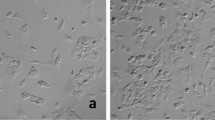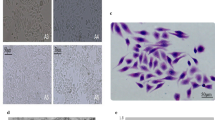Abstract
A new human bladder cancer cell line designated JMSU1 has been established from malignant ascitic fluid of a 75-year-old Japanese man with bladder cancer, and maintained in culture for more than 7 years and over 240 passages. Inverted phase-contrast microscopy revealed that JMSU1 was composed of morphologically distinct cells (polygonal to spindle-shaped cells), showing morphological heterogeneity in vitro. Histological examination of xenografts showed poorly differentiated transitional cell carcinoma, resembling the original tumor. Immunohistochemical staining for cytokeratin and electron microscopic examination suggested that JMSU1 was of epithelial origin. Chromosome analysis gave a modal number of 69 with no Y chromosome. Isozyme analysis (LDH, G6PD, and NP) showed the mobility pattern of human type B. DNA fingerprint analysis demonstrated that there was no cross-culture contamination of JMSU1 during the passages. In conclusion, a newly established and well-characterized cell line, JMSU1, offers promising material for the investigation of the biological properties of bladder cancer.
Similar content being viewed by others
References
Brown JL, Russell PJ, Philips J, Wortherspoon J, Raghavan D (1990) Clonal analysis of a bladder cancer cell line: an experimental model of tumor heterogeneity. Br J Cancer 61:369
Bubenik J, Baresova M, Viklicky V, Jakoubkova J, Sainerova H, Donner J (1973) Established cell line of urinary bladder carcinoma (T-24) containing tumor-specific antigen. Int J Cancer 11:765
Hastings RJ, Franks LM (1983) Cellular heterogeneity in a tissue culture cell line derived from a human bladder cancer. Br J Cancer 47:233
Heppner GH (1984) Tumor heterogeneity. Cancer Res 44:2259
Honma M, Kataoka E, Ohnishi K, Kikuno T, Takeuchi M, Hayashi M, Sofumi T, Mizusawa H (1993) Detection of recombinational mutations in cultured human cells by Southern blot analysis with minisatellite DNA probes. Mutat Res 286:165
Jeffreys AJ, Wilson V, Thein SL (1985) Individual specific ‘fingerprints’ of human DNA. Nature 314:76
Kato T, Ishikawa K, Nemoto R, Senoo A, Amano Y (1978) Morphological characterization of two established cell lines, T24 and MGHU1, derived from human urinary bladder carcinoma. Tohoku J Exp Med 124:339
Lin CW, Lin JC, Prout GR Jr (1985) Establishment and characterization of four human bladder tumor cell lines and sublines with different degrees of malignancy. Cancer Res 45:5070
Morita T, Kikuchi T, Kimura S, Kato K, Tokue A (1992) Clinical significance of serum S100ao protein in patients with renal cell carcinoma. Diagn Oncol 2:277
Nelson-Rees WA, Daniels DW, Flandermeyer RR (1981) Cross-contamination of cells in culture. Science 212:446
O'Brien SJ, Shannon JE, Mitchell HG (1980) A molecular approach to the identification and individualization of human and animal cells in culture: isozyme and allozyme genetic signatures. In Vitro 16:119
O'Tool CM, Povey S, Hepburn P, Franks LM (1983) Identity of some human bladder cancer cell lines. Nature 301:429
Peterson WD, Simpson WF, Ecklund PS, Stulberg CS (1973) Diploid and heteroploid human cell lines surveyed for Y chromosome fluorescence. Nature New Biol 242:22
Peterson WD, Simpson WF, Hukku B (1979) Cell culture characterization: monitoring for cell identification. Methods Enzymol 58:164
Rasheed S, Gardener MB, Rongey RW, Walter A, Nelson-Rees WA, Arnstein P (1977) Human bladder carcinoma: characterization of two new tumor cell lines and search for tumor viruses. J Natl Cancer Inst 58:881
Russell PJ, Jelbart M, Wills E, Singh S, Wass J, Wotherspoon J, Raghavan D (1988) Establishment and characterization of a new human bladder cancer cell line showing features of squamous and glandular differentiation. Int J Cancer 41:74
Thacker J, Michael BT, Debenham PG (1988) Fingerprinting cell lines: use of human hypervariable DNA probes to characterize mammalian cell cultures. Somat Cell Mol Genet 14:519
Wang HC, Federoff S (1972) Banding in human chromosomes treated with trypsin. Nature New Biol 235:52
Williams RD (1980) Human urologic cancer cell lines. Invest Urol 17:359
Author information
Authors and Affiliations
Rights and permissions
About this article
Cite this article
Morita, T., Shimohara, N., Honma, M. et al. Establishment and characterization of a new cell line from human bladder cancer (JMSU1). Urol. Res. 23, 143–149 (1995). https://doi.org/10.1007/BF00389565
Received:
Accepted:
Issue Date:
DOI: https://doi.org/10.1007/BF00389565




